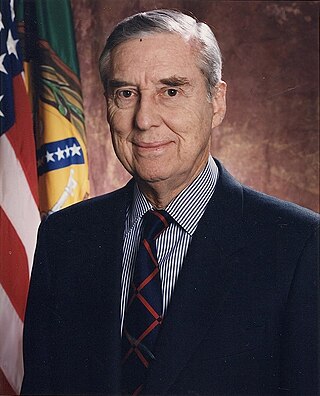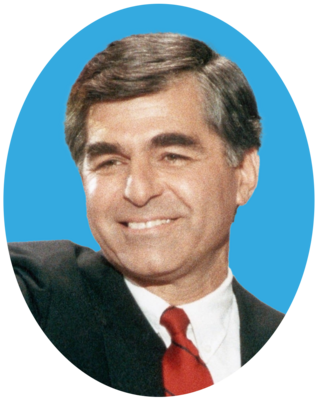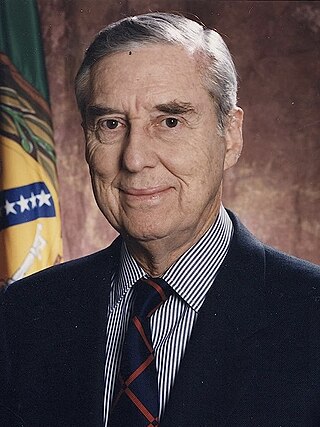
The 1988 United States presidential election was the 51st quadrennial presidential election held on Tuesday, November 8, 1988. Incumbent Republican Vice President George H. W. Bush defeated the Democratic Massachusetts Governor Michael Dukakis.

Michael Stanley Dukakis is an American retired lawyer and politician who served as governor of Massachusetts from 1975 to 1979 and from 1983 to 1991. He is the longest-serving governor in Massachusetts history and only the second Greek-American governor in U.S. history, after Spiro Agnew. He was nominated by the Democratic Party for president in the 1988 election, losing to the Republican nominee, Vice President George H. W. Bush.

Lloyd Millard Bentsen Jr. was an American politician who was a four-term United States Senator (1971–1993) from Texas and the Democratic Party nominee for vice president in 1988 on the Michael Dukakis ticket. He also served as the 69th United States Secretary of the Treasury under President Bill Clinton.
William R. Horton, commonly referred to as "Willie Horton", is an American convicted murderer who was the subject of a major issue in the 1988 presidential election. Horton had committed violent crimes while on furlough from prison, where he was serving a life sentence without the possibility of parole for murder. Released for a weekend as the beneficiary of a Massachusetts furlough program, he failed to return, and was later recaptured and convicted of committing assault, armed robbery, and rape in Maryland, where he remains incarcerated.

The 1988 Democratic National Convention was held at The Omni in Atlanta, Georgia, from July 18 to 21, 1988, to select candidates for the 1988 presidential election. At the convention Governor Michael Dukakis of Massachusetts was nominated for president and Senator Lloyd Bentsen of Texas for vice president. The chair of the convention was Speaker of the U.S. House of Representatives Jim Wright.

The 1992 presidential campaign of Bill Clinton, the then-governor of Arkansas, was announced on October 3, 1991, at the Old State House in Little Rock, Arkansas. After winning a majority of delegates in the Democratic primaries of 1992, the campaign announced that then-junior U.S. senator from Tennessee, Al Gore, would be Clinton's running mate. The Clinton–Gore ticket defeated Republican incumbent President George H. W. Bush and Vice President Dan Quayle in the presidential election on November 3, 1992, and took office as the 42nd president and 45th vice president, respectively, on January 20, 1993.

The 1988 United States Senate elections were elections for the United States Senate. Held on November 8, the 33 seats of Class 1 were contested in regular elections. In spite of the Republican victory by George H. W. Bush in the presidential election, the Democrats gained a net of one seat in the Senate. Seven seats changed parties, with four incumbents being defeated. The Democratic majority in the Senate increased by one to 55–to–45.

The 2004 United States presidential election was the 55th quadrennial presidential election, held on Tuesday, November 2, 2004. The Republican ticket of incumbent President George W. Bush and his running mate incumbent Vice President Dick Cheney were elected to a second term, defeating the Democratic ticket of John Kerry, a United States senator from Massachusetts and his running mate John Edwards, a United States senator from North Carolina.

"Senator, you're no Jack Kennedy" was a remark made during the 1988 United States vice presidential debate by Democratic nominee Senator Lloyd Bentsen to Republican nominee Senator Dan Quayle in response to Quayle's mentioning the name of John F. Kennedy, the Democratic 35th president of the United States, whom Bentsen knew from their time as congressmen from the 80th to 82nd Congresses. Since then, the words "You're no Jack Kennedy," or some variation on the remark, have become a part of the political lexicon as a way to deflate politicians or other individuals perceived as thinking too highly of themselves. Michael Dukakis and Bentsen later went on to lose the 1988 United States presidential election to George H. W. Bush and Quayle, who thus succeeded Bush as vice president of the United States.

From February 8 to June 14, 1988, voters of the Democratic Party chose its nominee for president in the 1988 United States presidential election.

The 1988 United States presidential election in North Carolina took place on November 8, 1988, and was part of the 1988 United States presidential election. Voters chose 13 representatives, or electors to the Electoral College, who voted for president and vice president.

The 1988 United States elections were held on November 8 and elected the President of the United States and members of the 101st United States Congress. Republican Vice President George H. W. Bush defeated Democratic Governor of Massachusetts Michael Dukakis. Despite Dukakis' defeat, the Democratic Party built on their majorities in Congress.

The 1988 United States Senate election in Texas was held on November 8, 1988. Incumbent Democratic U.S. Senator Lloyd Bentsen won re-election to a fourth term, defeating Republican U.S. Representative Beau Boulter. Bentsen easily won the Democratic nomination for another term, while Boulter came through a run-off in the Republican primary defeating Wes Gilbreath. After winning renomination, Bentsen was chosen by Democratic presidential nominee Michael Dukakis as his vice-presidential running mate and therefore ran for both the Senate and the vice-presidency at the same time. Although the presidential ticket lost the general election and did not carry Texas, Bentsen was always the favorite for the Senate election and won with 59.2% of the vote, compared to 40% for Boulter.

The 1970 United States Senate election in Texas was held on November 3, 1970. Incumbent Democratic U.S. Senator Ralph Yarborough was defeated by former U.S. Representative Lloyd Bentsen in the Democratic primary. Bentsen then defeated Republican U.S. Representative and future president George H. W. Bush in the general election. When Bush was running for president in 1988, his Democratic opponent, Massachusetts Governor Michael Dukakis, selected Bentsen as his vice presidential running mate.

The 1988 United States presidential election in Alabama took place on November 8, 1988. All fifty states, and the District of Columbia, were part of the 1988 presidential election. Alabama voters chose nine electors to the Electoral College, which selected the president and vice president. Alabama was won by incumbent United States Vice President George H. W. Bush of Texas, who was running against Massachusetts Governor Michael Dukakis. Bush ran with Indiana Senator Dan Quayle as Vice President, and Dukakis ran with Texas Senator Lloyd Bentsen.

The 1988 United States presidential election in Texas took place on November 8, 1988. All fifty states and the District of Columbia, were part of the 1988 United States presidential election. Texas voters chose 29 electors to the Electoral College, which selected the president and vice president.

This article lists those who were potential candidates for the Democratic nomination for Vice President of the United States in the 1988 election. Massachusetts Governor Michael Dukakis won the 1988 Democratic nomination for President of the United States, and chose Texas Senator Lloyd Bentsen as his running mate. Dukakis chose Bentsen in order to appeal to Southerners and in hopes of carrying Bentsen's home state of Texas. The strategy failed, as the Dukakis-Bentsen ticket went on to lose Texas and all other states in the South except West Virginia. The choice of Bentsen caused some backlash from Jesse Jackson, who had wanted to be chosen as the vice presidential nominee, and progressives such as Ralph Nader. Paul Brountas, a longtime Dukakis aide, led the search for Dukakis's running mate. The Dukakis–Bentsen ticket would lose to the Bush–Quayle ticket in the general election. Bentsen simultaneously ran for reelection as Senator, and easily won, despite the Dukakis-Bentsen ticket's double-digit loss in Texas.

This article lists those who were potential candidates for the Republican nomination for Vice President of the United States in the 1988 election. Incumbent Vice President George H. W. Bush won the 1988 Republican nomination for President of the United States, and chose Indiana Senator Dan Quayle as his running mate. The selection of Quayle surprised many of Bush's closest advisers, who had expected Bush to pick a more well-known running mate. However, Bush adviser Roger Ailes helped convince Bush that Quayle would be able to effectively attack the Democratic presidential nominee, Michael Dukakis. Bush also liked Quayle's youth and felt that Quayle would make for a loyal vice president. The Bush–Quayle ticket ultimately defeated the Dukakis–Bentsen ticket in the 1988 election.

The 1988 presidential campaign of George H. W. Bush, the 43rd vice president of the United States under President Ronald Reagan, began when he announced he was running for the Republican Party's nomination in the 1988 U.S. presidential election on October 13, 1987. Bush won the 1988 election against Democratic nominee Michael Dukakis on November 8, 1988. He was subsequently inaugurated as president on January 20, 1989.
The following table is the list of newspaper endorsements in the 1992 United States presidential election. It mostly contains major newspapers of 1992, which made their presidential endorsement from September–November 1992. Many newspaper, who had made their endorsement for George H. W. Bush in 1988 presidential election endorsed Bill Clinton in the 1992 election. Harford Courant's 1992 endorsement of Clinton was their first Democratic presidential endorsement in its 228 years of continuous publication.

















